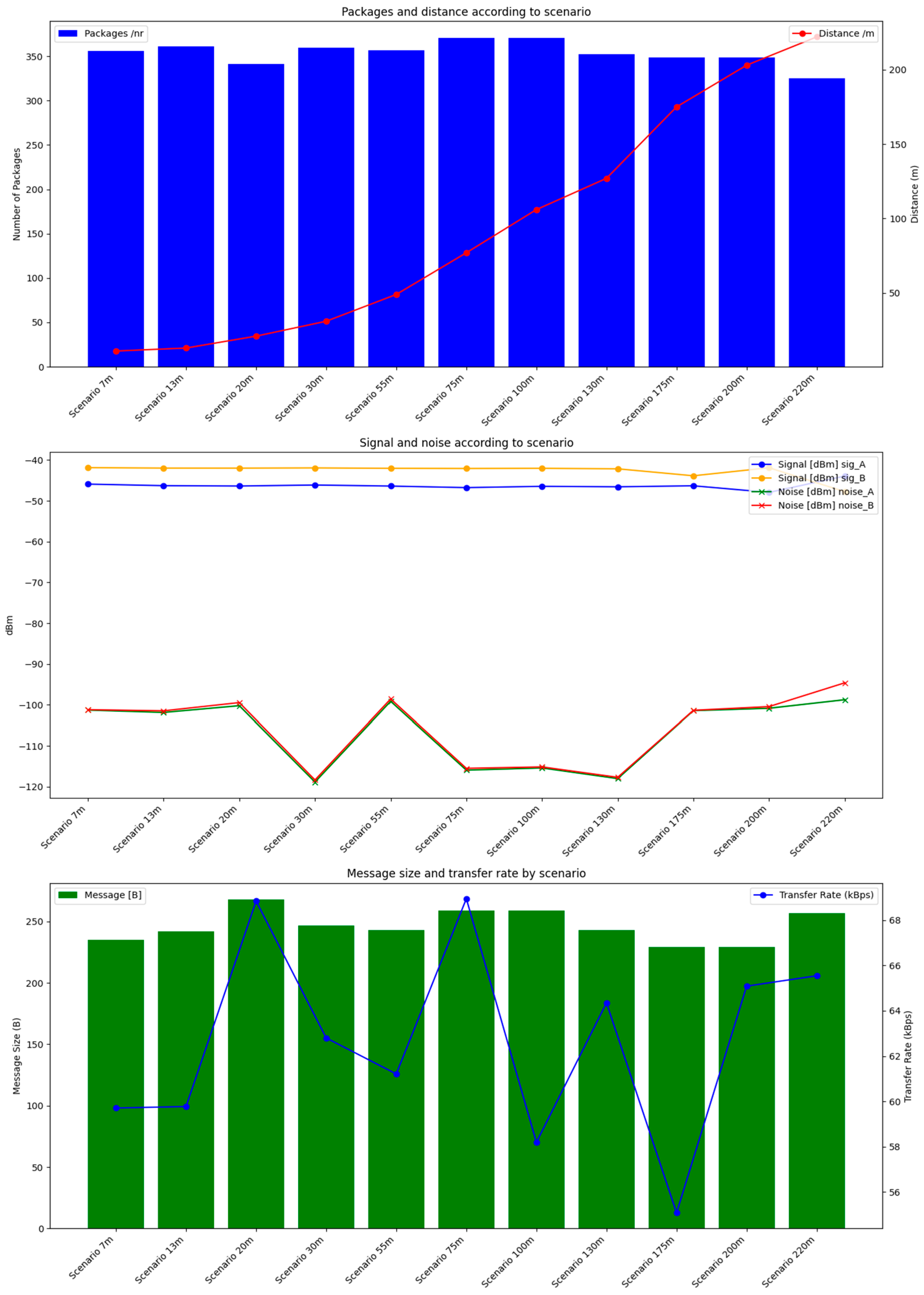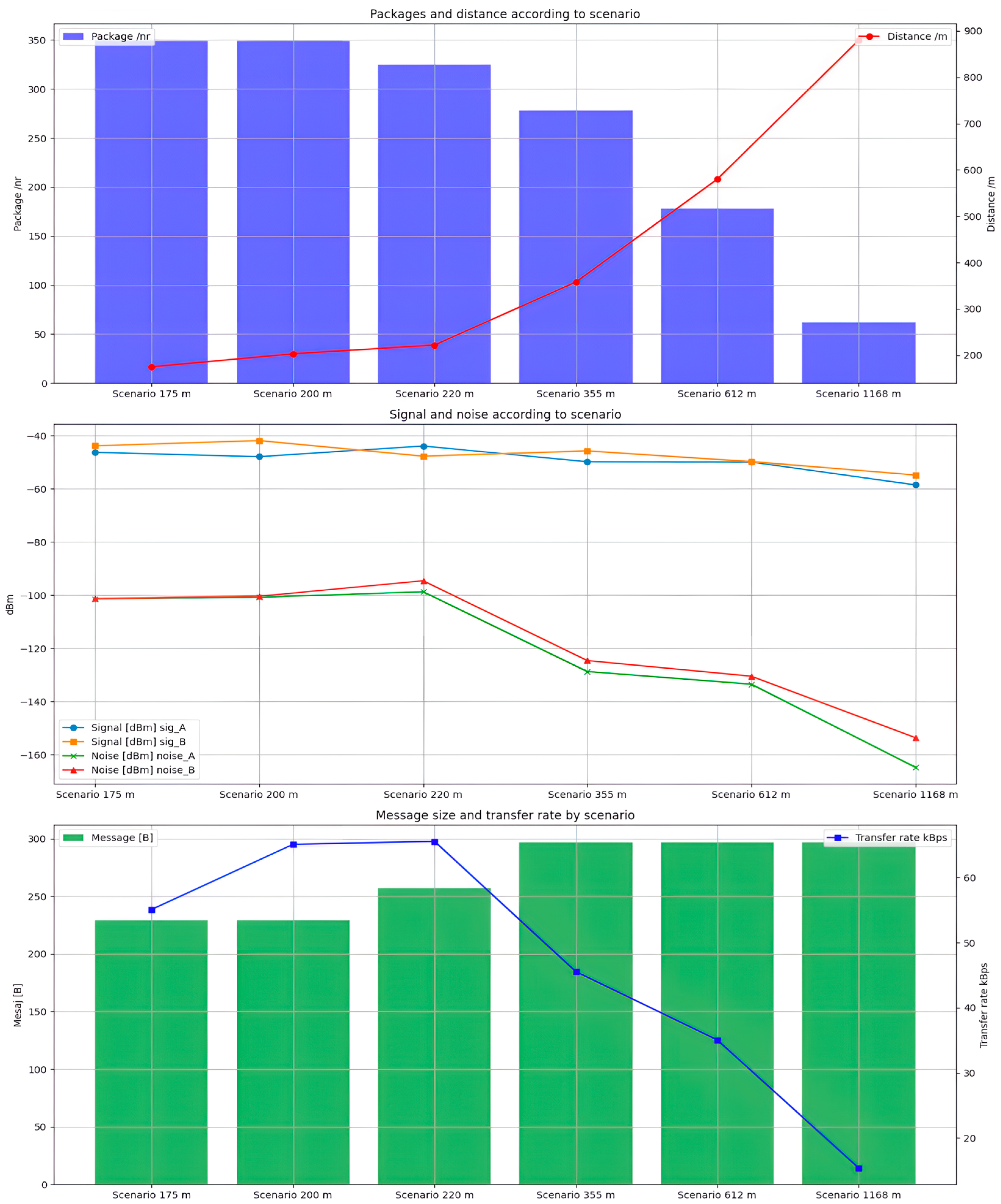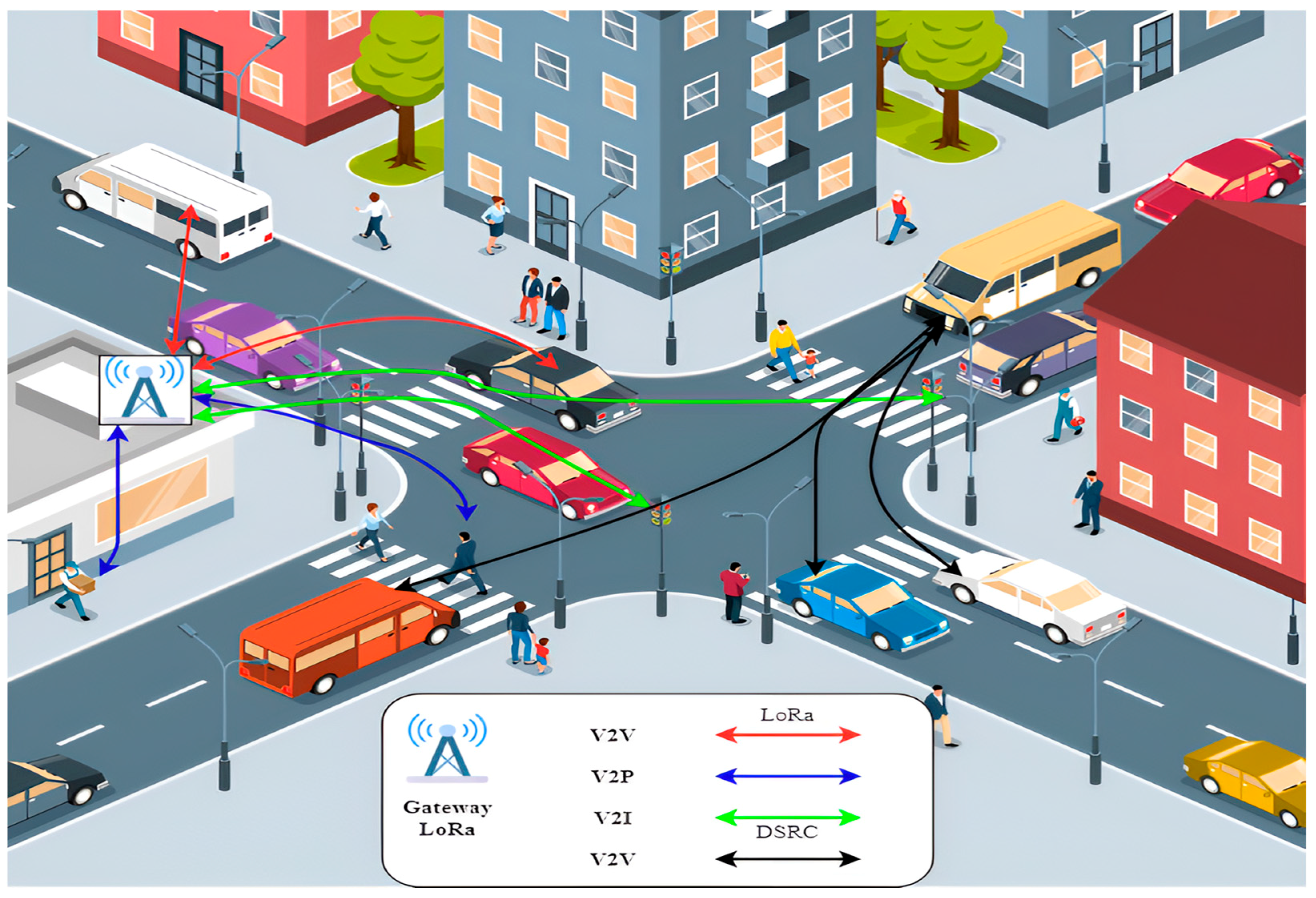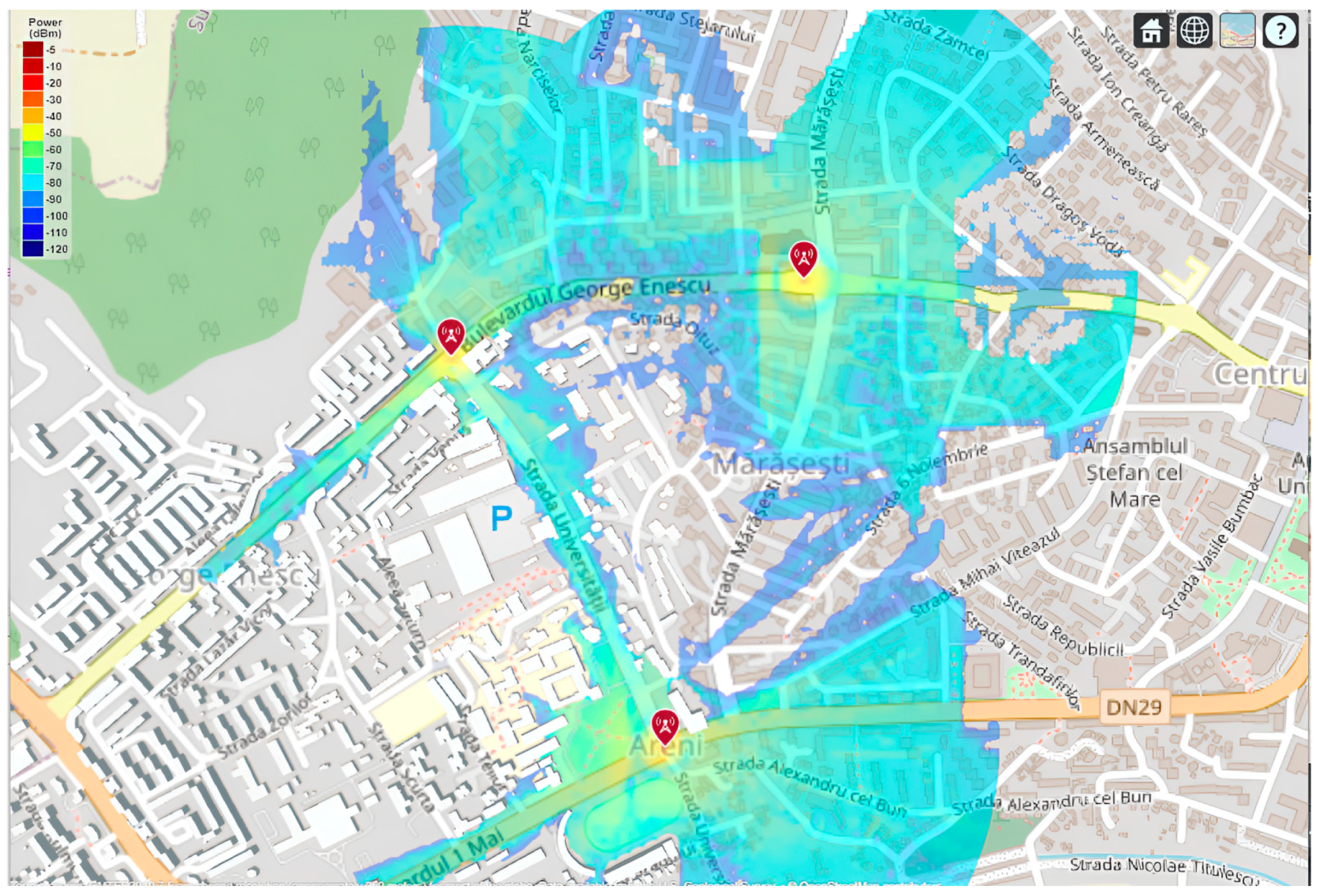Enhancing Scalability of C-V2X and DSRC Vehicular Communication Protocols with LoRa 2.4 GHz in the Scenario of Urban Traffic Systems
Abstract
1. Introduction
2. State of Developments of Vehicular Communications Based on C-V2X, DSRC and LoRa
2.1. Current Status of C-V2X Developments
- ✓
- A new wave of urbanization will put pressure on existing transport infrastructure.
- ✓
- Increasingly stringent emission policies and regulations imposed by governments.
- ✓
- Increased pressure on public transport and logistics/delivery services due to the emergence of different business prospects.
- ✓
- Effective use of real-time traffic data and open data for traffic management.
- ✓
- Elimination of road accidents,
- ✓
- Implementation of an adaptive support system to manage high traffic flows,
- ✓
- Increasing vehicle utilization, and
- ✓
2.2. Current Status of DSRC Developments
2.3. Current State of LoRa 2.4 GHz Developments
3. Previous Results C-V2X and DSRC vs. LoRa 2.4 GHz Approach
3.1. Handling Particular Cases and Re-Testing Scenarios at Infrastructure Level Using LoRa 2.4 GHz
3.2. Practical and Deterministic Analysis of LoRa Capabilities within Intelligent Transport Systems and Smart Cities
- ✓
- Areas of signal intensity are represented by a color range from blue to green. Regions colored in green indicate optimal signal coverage, while areas colored in blue signal low signal strength. This visual coding allows a quick and accurate assessment of network performance at different locations in the urban area.
- ✓
- Buildings and other structures in the urban environment create shadows and reflections that adversely affect radio signal propagation. These phenomena are illustrated in the 3D visualization by chromatic variations in the vicinity of obstacles, highlighting how these structures disturb and reflect the signal. The analysis of these effects allows the identification of critical points where the signal is attenuated, thus helping to optimize the positioning of network nodes to ensure the most uniform and robust coverage.
4. Discussion and Conclusions
Author Contributions
Funding
Data Availability Statement
Acknowledgments
Conflicts of Interest
References
- Road Traffic Injuries. Available online: https://www.who.int/news-room/fact-sheets/detail/road-traffic-injuries (accessed on 8 July 2024).
- Decade of Action for Road Safety 2021–2030. Available online: https://www.who.int/teams/social-determinants-of-health/safety-and-mobility/decade-of-action-for-road-safety-2021-2030 (accessed on 8 July 2024).
- Safety|US Department of Transportation. Available online: https://www.transportation.gov/priorities/safety (accessed on 8 July 2024).
- Texts Adopted—EU Road Safety Policy Framework 2021–2030—Recommendations on Next Steps towards “Vision Zero”—Wednesday. 6 October 2021. Available online: https://www.europarl.europa.eu/doceo/document/TA-9-2021-0407_EN.html (accessed on 8 July 2024).
- Wiseman, Y. Autonomous Vehicles. In Encyclopedia of Information Science and Technology, 5th ed.; IGI Global: Hershey, PA, USA, 2020; pp. 1–11. ISBN 9781799834809. [Google Scholar]
- Valean, A.I. EU Road Safety Policy Framework 2021–2030-Next Steps towards “Vision Zero”; European Commission: Brussels, Belgium, 2019. [Google Scholar]
- IEEE Std 802.11-2020 (Revision of IEEE Std 802.11-2016); IEEE Standard for Information Technology--Telecommunications and Information Exchange between Systems-Local and Metropolitan Area Networks--Specific Requirements-Part 11: Wireless LAN Medium Access Control (MAC) and Physical Layer (PHY) Specifications-Redline. 26 February 2021; pp. 1–7524.
- IEEE Std 802.11p-2010 (Amendment to IEEE Std 802.11-2007 as amended by IEEE Std 802.11k-2008, IEEE Std 802.11r-2008, IEEE Std 802.11y-2008, IEEE Std 802.11n-2009, and IEEE Std 802.11w-2009); IEEE Standard for Information Technology--Local and Metropolitan Area Networks--Specific Requirements--Part 11: Wireless LAN Medium Access Control (MAC) and Physical Layer (PHY) Specifications Amendment 6: Wireless Access in Vehicular Environments. 15 July 2010; pp. 1–51. [CrossRef]
- Pérez, D.V.; Linnartz, J.P.M. Modelling message flows in Networked Lighting Control Systems using Trickle and CSMA. In Proceedings of the 2014 IEEE 21st Symposium on Communications and Vehicular Technology in the BeNeLux, Delft, The Netherlands, 10 November 2014; ISBN 9781479980307. [Google Scholar]
- Miao, Y.; Dong, X.; Bourassa, M.A.; Zhu, D. Effects of Different Wave Spectra on Wind-Wave Induced Doppler Shift Estimates. In Proceedings of the International Geoscience and Remote Sensing Symposium (IGARSS), Waikoloa, HI, USA, 26 September 2020; Institute of Electrical and Electronics Engineers Inc.: New York City, NY, USA, 2020; pp. 5705–5708. [Google Scholar]
- Rajput, N.S. Measurement of IEEE 802.11p Performance for Basic Safety Messages in Vehicular Communications. In Proceedings of the 2018 IEEE International Conference on Advanced Networks and Telecommunications Systems (ANTS), Indore, India, 16–19 December 2018. [Google Scholar]
- Yang, Z.; Wei, L. Logic Circuit and Memory Design for In-Memory Computing Applications using Bipolar RRAMs. In Proceedings of the 2019 IEEE International Symposium on Circuits and Systems (ISCAS), Sapporo, Japan, 26–29 May 2019; ISBN 9781728103976. [Google Scholar]
- Cao, M.; Shuai, Q.; Li, V.O. Emergency Vehicle-Centered Traffic Signal Control in Intelligent Transportation Systems. In Proceedings of the 2019 IEEE Intelligent Transportation Systems Conference—ITSC, Auckland, New Zealand, 27–30 October 2019; ISBN 9781538670248. [Google Scholar]
- Najm, W.G.; Koopmann, J.; Smith, J.D.; Brewer, J. Frequency of Target Crashes for IntelliDrive Safety Systems; National Highway Traffic Safety Administration: Washington, DC, USA, 2010. [Google Scholar]
- European Transport Policy. Europe on the Move—Volume 1|EESC. Available online: https://www.eesc.europa.eu/en/our-work/publications-other-work/publications/european-transport-policy-europe-move-volume-1 (accessed on 8 July 2024).
- Kang, Y.; Tian, C. Study on the Emission of Connected Autonomous Vehicle Considering the Control of Electronic Throttle Opening. World Electr. Veh. J. 2024, 15, 233. [Google Scholar] [CrossRef]
- Neugebauer, M.; Żebrowski, A.; Esmer, O. Cumulative Emissions of CO2 for Electric and Combustion Cars: A Case Study on Specific Models. Energies 2022, 15, 2703. [Google Scholar] [CrossRef]
- Wittmann, M.; Neuner, L.; Lienkamp, M. A Predictive Fleet Management Strategy for on-Demand Mobility Services: A Case Study in Munich. Electronics 2020, 9, 1021. [Google Scholar] [CrossRef]
- Mertens, J.C.; Knies, C.; Diermeyer, F.; Escherle, S.; Kraus, S. The Need for Cooperative Automated Driving. Electronics 2020, 9, 754. [Google Scholar] [CrossRef]
- Wang, Q.; Zhang, R.; Wang, Y.; Lv, S. Machine Learning-Based Driving Style Identification of Truck Drivers in Open-Pit Mines. Electronics 2020, 9, 19. [Google Scholar] [CrossRef]
- Zhang, T.; Zhou, W.; Meng, F.; Li, Z. Efficiency Analysis and Improvement of an Intelligent Transportation System for the Application in Greenhouse. Electronics 2019, 8, 946. [Google Scholar] [CrossRef]
- Wu, Y.; Lee, W.W.; Gong, X.; Wang, H. A Hybrid Intrusion Detection Model Combining SAE with Kernel Approximation in Internet of Things. Sensors 2020, 20, 5710. [Google Scholar] [CrossRef] [PubMed]
- Li, Y.; Liu, W.; Liu, Q.; Zheng, X.; Sun, K.; Huang, C. Complying with ISO 26262 and ISO/SAE 21434: A Safety and Security Co-Analysis Method for Intelligent Connected Vehicle. Sensors 2024, 24, 1848. [Google Scholar] [CrossRef] [PubMed]
- Arena, F.; Pau, G.; Severino, A. A Review on IEEE 802.11p for Intelligent Transportation Systems. J. Sens. Actuator Netw. 2020, 9, 22. [Google Scholar] [CrossRef]
- Iriqat, S.; Yenikaya, S.; Secmen, M. Dual-Band 2 × 1 Monopole Antenna Array and Its MIMO Configuration for WiMAX, Sub-6 GHz, and Sub-7 GHz Applications. Electronics 2024, 13, 1502. [Google Scholar] [CrossRef]
- IEEE Std 802.11a-1999; IEEE Standard for Telecommunications and Information Exchange between Systems-LAN/MAN Specific Requirements-Part 11: Wireless Medium Access Control (MAC) and Physical Layer (PHY) Specifications: High Speed Physical Layer in the 5 GHz Band. 30 December 1999; pp. 1–102. [CrossRef]
- Souri, A.; Zarei, M.; Hemmati, A.; Gao, M. A Systematic Literature Review of Vehicular Connectivity and V2X Communications: Technical Aspects and New Challenges. Int. J. Commun. Syst. 2024, 37, e5780. [Google Scholar] [CrossRef]
- Batalla, J.M.; Sujecki, S.; Oko, J.; Kelner, J.M. Cost-Effective Measurements of 5G Radio Resources Allocation for Telecom Market Regulator’s Monitoring. In Proceedings of the PE-WASUN 2022—Proceedings of the 19th ACM International Symposium on Performance Evaluation of Wireless Ad Hoc, Sensor, and Ubiquitous Networks, Montreal, QC, Canada, 24–28 October 2022; pp. 83–90. [Google Scholar] [CrossRef]
- Garrott, W.R. The anticipated effect of improvements to automotive electronics on safety during the years 2009 through 2015. In Proceedings of the 2008 IEEE International Conference on Vehicular Electronics and Safety, Columbus, OH, USA, 22–24 September 2008; IEEE Xplore: Piscataway, NJ, USA, 2008. ISBN 9781424423606. [Google Scholar]
- Zhang, Y.; Zhang, J. Design and Optimization of Cluster-Based DSRC and C-V2X Hybrid Routing. Appl. Sci. 2022, 12, 6782. [Google Scholar] [CrossRef]
- Petrov, T.; Sevcik, L.; Pocta, P.; Dado, M. A Performance Benchmark for Dedicated Short-Range Communications and Lte-Based Cellular-V2x in the Context of Vehicle-to-Infrastructure Communication and Urban Scenarios. Sensors 2021, 21, 5095. [Google Scholar] [CrossRef] [PubMed]
- IEEE Std 802.11bd-2022 (Amendment to IEEE Std 802.11-2020 as amended by IEEE Std 802.11ax-2021, IEEE Std 802.11ay-2021, IEEE Std 802.11ba-2021, IEEE Std 802.11-2020/Cor 1-2022, and IEEE Std 802.11az-2022); IEEE Standard for Information Technology--Telecommunications and Information Exchange between Systems Local and Metropolitan Area Networks--Specific Requirements Part 11: Wireless LAN Medium Access Control (MAC) and Physical Layer (PHY) Specifications Amendment 5: Enhancements for Next Generation V2X. 10 March 2023; pp. 1–144. [CrossRef]
- Nguyen, H.; Noor-A-Rahim, M.; Liu, Z.; Jamaludin, D.; Guan, Y.L. A Semi-Empirical Performance Study of Two-Hop DSRC Message Relaying at Road Intersections. Information 2018, 9, 147. [Google Scholar] [CrossRef]
- Albattah, W.; Habib, S.; Alsharekh, M.F.; Islam, M.; Albahli, S.; Dewi, D.A. An Overview of the Current Challenges, Trends, and Protocols in the Field of Vehicular Communication. Electronics 2022, 11, 3581. [Google Scholar] [CrossRef]
- Zhao, P.; Wang, X.; Zhang, K.; Jin, Y.; Zheng, G. Doppler Modeling and Simulation of Train-to-Train Communication in Metro Tunnel Environment. Sensors 2022, 22, 4289. [Google Scholar] [CrossRef] [PubMed]
- Choi, J.; Ahn, S. A 5.9 GHz Channel Characterization at Railroad Crossings for Train-to-Infrastructure (T2I) Communications. Electronics 2023, 12, 2400. [Google Scholar] [CrossRef]
- Wang, T.; Hussain, A.; Cao, Y.; Gulomjon, S. An Improved Channel Estimation Technique for Ieee 802.11p Standard in Vehicular Communications. Sensors 2019, 19, 98. [Google Scholar] [CrossRef] [PubMed]
- ICICI-BME 4. 2015 Bandung; Bandung Institute of Technology; IEEE International Conference on Service-Oriented Computing and Applications; International Conference on Instrumentation, C.; ICICI-BME 4 2015.11.02-03 Bandung. In Proceedings of the 2015 4th International Conference on Instrumentation, Communications, Information Technology, and Biomedical Engineering (ICICI-BME), Bandung, Indonesia, 2–3 November 2015; ISBN 9781467378000.
- Khan, U.A.; Lee, S.S. Multi-Layer Problems and Solutions in VANETs: A Review. Electronics 2019, 8, 204. [Google Scholar] [CrossRef]
- Hota, L.; Nayak, B.P.; Kumar, A.; Sahoo, B.; Ali, G.G.M.N. A Performance Analysis of VANETs Propagation Models and Routing Protocols. Sustainability 2022, 14, 1379. [Google Scholar] [CrossRef]
- Augustin, A.; Yi, J.; Clausen, T.; Townsley, W.M. A Study of Lora: Long Range & Low Power Networks for the Internet of Things. Sensors 2016, 16, 1466. [Google Scholar] [CrossRef]
- Lima, W.G.; Lopes, A.V.R.; Cardoso, C.M.M.; Araújo, J.P.L.; Neto, M.C.A.; Tostes, M.E.L.; Nascimento, A.A.; Rodriguez, M.; Barros, F.J.B. LoRa Technology Propagation Models for IoT Network Planning in the Amazon Regions. Sensors 2024, 24, 1621. [Google Scholar] [CrossRef]
- Zhang, Z.; Cao, S.; Wang, Y. A Long-Range 2.4G Network System and Scheduling Scheme for Aquatic Environmental Monitoring. Electronics 2019, 8, 909. [Google Scholar] [CrossRef]
- Zhang, Z.; Zhou, C.; Sheng, L.; Cao, S. Optimization Schemes for UAV Data Collection with LoRa 2.4 GHz Technology in Remote Areas without Infrastructure. Drones 2022, 6, 173. [Google Scholar] [CrossRef]
- Kane, L.; Liu, V.; McKague, M.; Walker, G. An Experimental Field Comparison of Wi-Fi HaLow and LoRa for the Smart Grid. Sensors 2023, 23, 7409. [Google Scholar] [CrossRef]
- Janssen, T.; Bnilam, N.; Aernouts, M.; Berkvens, R.; Weyn, M. Lora 2.4 Ghz Communication Link and Range. Sensors 2020, 20, 4366. [Google Scholar] [CrossRef] [PubMed]
- Havriliuc, S.; Coca, E.; Lavric, A.; Popa, V.; Petrariu, A.I. Expanding IoT Connectivity by Using 2.4 GHz LoRa Technology. In Proceedings of the 2024 17th International Conference on Development and Application Systems, DAS, Suceava, Romania, 23–25 May 2024; Institute of Electrical and Electronics Engineers Inc.: New York City, NY, USA, 2024; pp. 87–90. [Google Scholar]
- Ragnoli, M.; Colaiuda, D.; Leoni, A.; Ferri, G.; Barile, G.; Rotilio, M.; Laurini, E.; De Berardinis, P.; Stornelli, V. A LoRaWAN Multi-Technological Architecture for Construction Site Monitoring. Sensors 2022, 22, 8685. [Google Scholar] [CrossRef]
- Guo, Q.; Yang, F.; Wei, J. Experimental Evaluation of the Packet Reception Performance of LoRa. Sensors 2021, 21, 1071. [Google Scholar] [CrossRef]
- Zadobrischi, E.; Dimian, M.; Negru, M. The Utility of Dsrc and V2x in Road Safety Applications and Intelligent Parking: Similarities, Differences, and the Future of Vehicular Communication. Sensors 2021, 21, 7237. [Google Scholar] [CrossRef]
- Miao, L.; Virtusio, J.J.; Hua, K.L. Pc5-Based Cellular-V2x Evolution and Deployment. Sensors 2021, 21, 843. [Google Scholar] [CrossRef]
- Cui, G.; Zhang, W.; Xiao, Y.; Yao, L.; Fang, Z. Cooperative Perception Technology of Autonomous Driving in the Internet of Vehicles Environment: A Review. Sensors 2022, 22, 5535. [Google Scholar] [CrossRef] [PubMed]
- Zadobrischi, E.; Dimian, M. Inter-Urban Analysis of Pedestrian and Drivers through a Vehicular Network Based on Hybrid Communications Embedded in a Portable Car System and Advanced Image Processing Technologies. Remote Sens. 2021, 13, 1234. [Google Scholar] [CrossRef]
- Wiseman, Y. Autonomous Vehicles Will Spur Moving Budget from Railroads to Roads. Int. J. Intell. Unmanned Syst. 2024, 12, 19–31. [Google Scholar] [CrossRef]
- Colombi, D.; Joshi, P.; Xu, B.; Ghasemifard, F.; Narasaraju, V.; Törnevik, C. Analysis of the Actual Power and EMF Exposure from Base Stations in a Commercial 5G Network. Appl. Sci. 2020, 10, 5280. [Google Scholar] [CrossRef]
- Saari, M.; Muzaffar Bin Baharudin, A.; Sillberg, P.; Hyrynsalmi, S.; Yan, W. LoRa-A Survey of Recent Research Trends. In Proceedings of the 2018 41st International Convention on Information and Communication Technology, Electronics and Microelectronics (MIPRO), Opatija, Croatia, 21–25 May 2018. [Google Scholar]
- Brahim, A.; Khedher, L.; Górriz, J.M.; Ramírez, J.; Toumi, H.; Lespessailles, E.; Jennane, R.; El Hassouni, M. A proposed computer-aided diagnosis system for Parkinson’s disease classification using 123I-FP-CIT imaging. In Proceedings of the 2017 International Conference on Advanced Technologies for Signal and Image Processing (ATSIP), Fez, Morocco, 22–24 May 2017; ISBN 9781538605516. [Google Scholar]
- Yun, Z.; Iskander, M.F. Ray Tracing for Radio Propagation Modeling: Principles and Applications. IEEE Access 2015, 3, 1089–1100. [Google Scholar] [CrossRef]






| Parameters | DSRC | C-V2X |
|---|---|---|
| Protocol | IEEE 802.11p | C-V2X Rel. 14/15 (for 4G-LTE) and Rel 16 (for 5G NR) |
| Modulation | BPSK/QPSK/16QAM/64QAM, Orthogonal Frequency Division Multiplexing (OFDM) | QPSK/16QAM/64QAM for 4G-LTE, OFDM (QAM + FDM) for 5G, Single Carrier—Frequency Division Multiplexing (SC-FDM) |
| Transmission time | 0.4 ms | 1 ms |
| Symbol duration | 8 μS | 71 μS |
| Security | Public-key cryptography requires the isolation of secure functions from insecure ones. | Same |
| Transfer rate | 27 Mbps | 4–12 Mbps, 50 Mbps peak download |
| Time sync. | Asynchronous | Synchronous |
| Maximum latency | ~150 ms | Less than 50 ms in 4G-LTE tests |
| Parameters | LoRa Sub-GHz | LoRa 2.4 GHz |
|---|---|---|
| Spreading Factor (SF) | From 6 to 12 | From 5 to 12 |
| Bandwidth (kHz) (BW) | 125, 250, 500 | 203, 406, 812, 1625 |
| Coding Rate (CR) | 4/5, 4/6, 4/7, 4/8 | |
| Data Rates | 183 bps–62.5 kbps | 297 bps–202 kbps |
| Link Budget | 168 dB (SX1276 chip) | 144.5 dB (SX1280 chip) |
| Consumption | Tx: 28 mA at 13 dBm Rx: 11.5 mA SX1276 chip | Tx: 24 mA at 12.5 dBm Rx: 7 mA for BW = 812 SX1280 chip |
| Time sync. | Asynchronous | Synchronous |
| Maximum latency | ~150 ms | Less than 50 ms in 4G-LTE tests |
| Properties | Technical Features |
|---|---|
| 14 dBm | |
| 2 dBi | |
| 8 dBi | |
| Distance (d) | 500 m |
| Frequency (f) | 2.4 GHz |
| −174 dBm/Hz |
Disclaimer/Publisher’s Note: The statements, opinions and data contained in all publications are solely those of the individual author(s) and contributor(s) and not of MDPI and/or the editor(s). MDPI and/or the editor(s) disclaim responsibility for any injury to people or property resulting from any ideas, methods, instructions or products referred to in the content. |
© 2024 by the authors. Licensee MDPI, Basel, Switzerland. This article is an open access article distributed under the terms and conditions of the Creative Commons Attribution (CC BY) license (https://creativecommons.org/licenses/by/4.0/).
Share and Cite
Zadobrischi, E.; Havriliuc, Ș. Enhancing Scalability of C-V2X and DSRC Vehicular Communication Protocols with LoRa 2.4 GHz in the Scenario of Urban Traffic Systems. Electronics 2024, 13, 2845. https://doi.org/10.3390/electronics13142845
Zadobrischi E, Havriliuc Ș. Enhancing Scalability of C-V2X and DSRC Vehicular Communication Protocols with LoRa 2.4 GHz in the Scenario of Urban Traffic Systems. Electronics. 2024; 13(14):2845. https://doi.org/10.3390/electronics13142845
Chicago/Turabian StyleZadobrischi, Eduard, and Ștefan Havriliuc. 2024. "Enhancing Scalability of C-V2X and DSRC Vehicular Communication Protocols with LoRa 2.4 GHz in the Scenario of Urban Traffic Systems" Electronics 13, no. 14: 2845. https://doi.org/10.3390/electronics13142845
APA StyleZadobrischi, E., & Havriliuc, Ș. (2024). Enhancing Scalability of C-V2X and DSRC Vehicular Communication Protocols with LoRa 2.4 GHz in the Scenario of Urban Traffic Systems. Electronics, 13(14), 2845. https://doi.org/10.3390/electronics13142845













